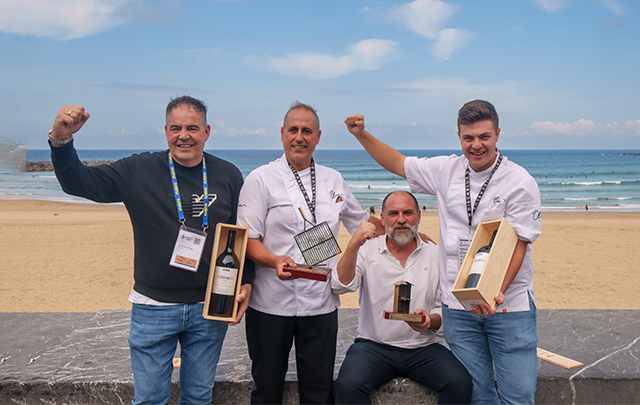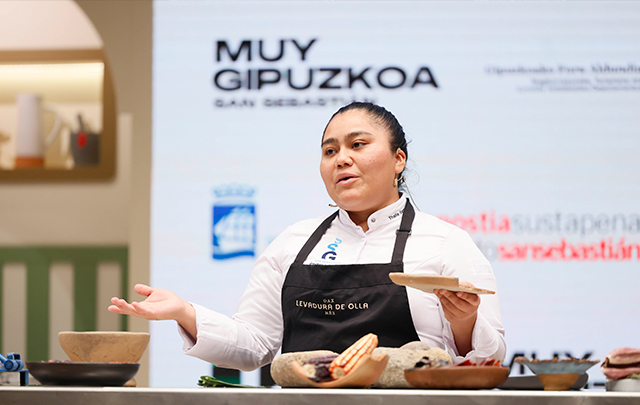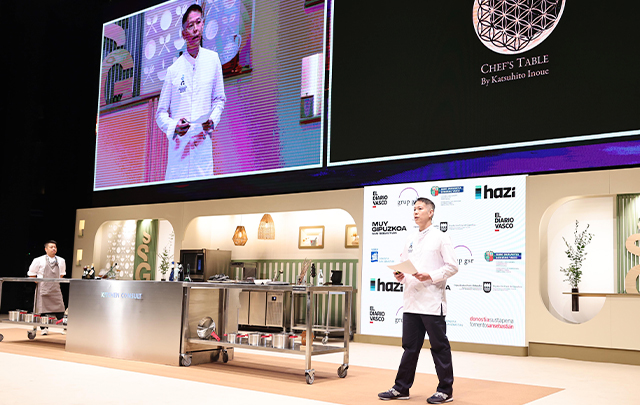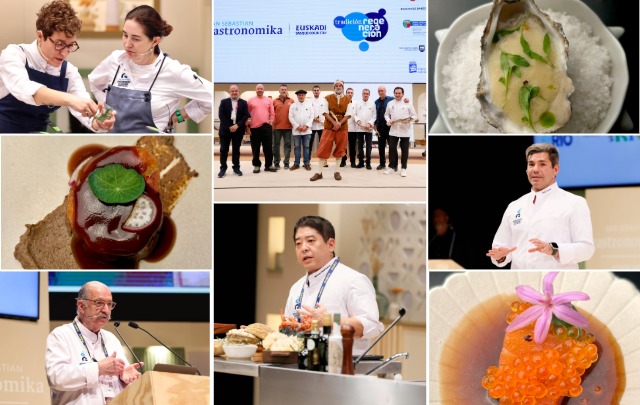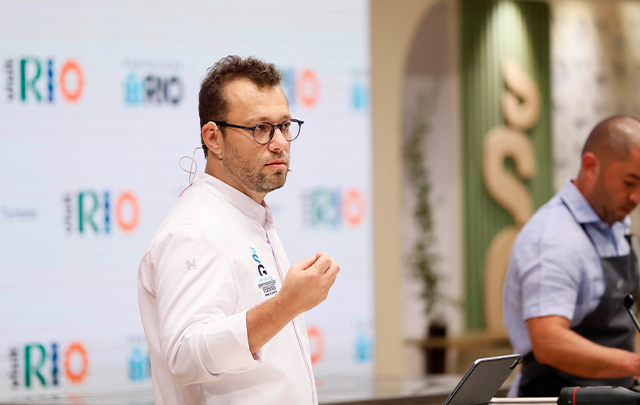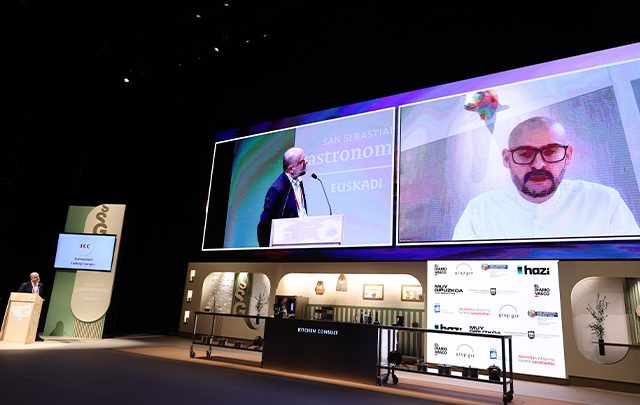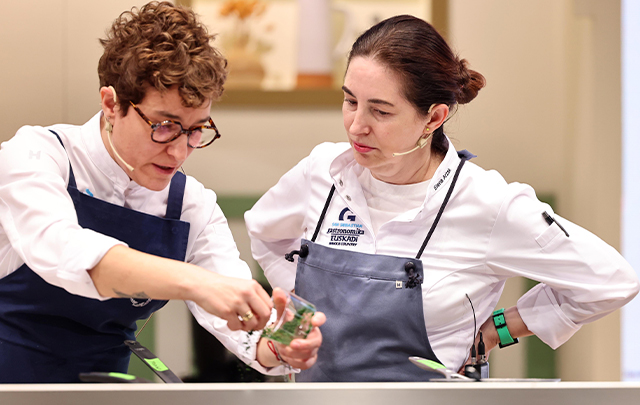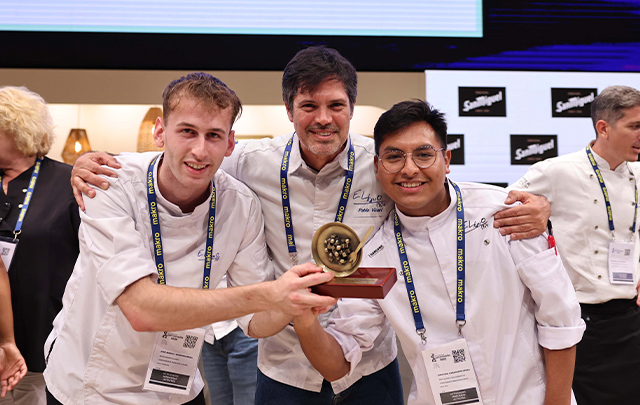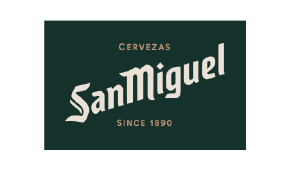News
The young restaurant Artesana Santa Eulàlia, located in L'Hospitalet de Llobregat, won the World Callos Championship at Gastronomika.
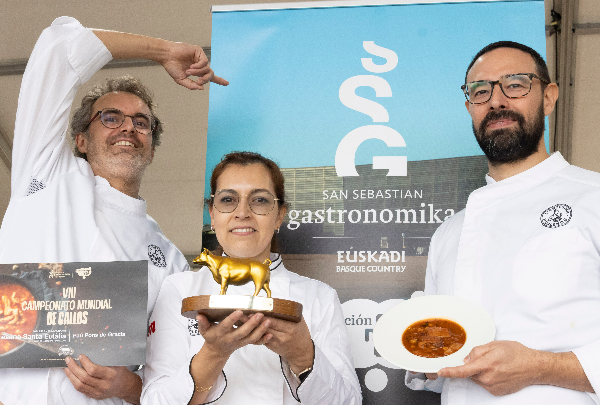
L'Artesana Santa Eulàlia, a restaurant in L'Hospitalet de Llobregat (Barcelona) run by three young chefs, Romina Reyes, Pau Pons and Héctor Barbero, who base their menu on stews and simple dishes, has won the 8th Pedro Martino World Tripe Championship. The restaurant surprised the jury with an original, well-executed, refined and bold recipe, which stood out in a competition full of orthodox and prudent dishes, according to Benjamín Lana, a jury member and director of the congress.
Just before the jury announced the winner of this year's tripe dish competition, presenter, journalist and tavern owner Alberto Fernández Bombín and the competition's founder, Asturian chef Pedro Martino, discussed the limits of adapting traditional recipes. "The only limit is denaturation," Martino reflected. This is a relevant debate because the winning tripe recipe is not one that has been passed down through the generations, but rather 'our own creation based on a Rioja-style tripe recipe to which we added Catalan "cap i pota" (snout, face and cow's feet) and chickpeas', as Pau Pons explained.
Of the ten recipes, the winner was the only one to include chickpeas this year, and one of the few with a hint of spice. The stew had the perfect consistency and smoothness, allowing each ingredient's texture to be clearly distinguished. Incidentally, the prize is like the proverbial loaf of bread under the arm with which, they say, children are born, because the business has just opened its doors. “We started with L'Artesana in Poblenou, and the warm welcome we received encouraged us to open a second location,” explained Pau Pons, who, like his colleagues, was excited and a little overwhelmed. “We are a neighbourhood eatery and we try to offer good home cooking at affordable prices. We came here to enjoy ourselves, so it was a big surprise to win the prize,” he concluded.
As every year, the competition was of a very high standard. ‘You don't just enter this competition. We spend the whole year looking for people who make wonderful callos,’ said Pedro Martino. This year's winners were Cristina Rei from La Gitana in Gijón, Asturias; Raúl del Moral from San Remo in Palencia; David Morera from Deliri in Barcelona; Iván Rozas from Bar O Timón in La Coruña; Santiago Ramírez from Bar Taberna Solana in Ampuero, Cantabria; Conchi Jurado from Bikandi Etxea in Bilbao; Lucía Fernández from La Tabernilla de Oviedo in Oviedo; Adrián Collantes from La Barra de la Tasquería in Madrid; and Wahiba Kebir Tio from Hevia in Madrid.
Most of the stews were very similar: tripe without vegetables (except for the winning entry), and all of them had silky, clean, tasty, mellow sauces. However, they were all very cautious in terms of spiciness. "Restaurateurs are clearly trying to ensure their dishes please a wide and diverse audience," reflected Elena Arzak (Arzak***), a jury member alongside Miguel Laredo (Taberna Laredo), Sacha Hormaechea (Sacha), Pablo Loureiro (Casa Urola), Benjamín Lana (director of San Sebastian Gastronomika and general manager of Vocento Gastronomía) and Guillermo Elejabeitia (food journalist and member of a family of restaurateurs who run the Echaurren hotel and restaurant — incidentally, the first championship winner).
Although they are a main course, the tripe was the prologue to the 2025 edition of San Sebastian Gastronomika, which begins tomorrow under the slogan 'Tradition-Regeneration', as well as the starter for the Tavern Forum, a section of the congress that debuted to great acclaim in 2024.
Despite the rainy day, the Tavern Forum sessions on the Kursaal terrace were full of people from early on. The programme included several other interesting proposals, such as a presentation by sociologist Javier Rueda on the role of bars in community building and a special tasting session led by Master of Wine Fernando Mora. This tasting journey explored the history of bar drinking through its most significant wines and the glasses and cups used to serve them.
Javier Rueda, a Malaga-born sociologist and author of Utopías de barra de bar (Bar Counter Utopias), has dedicated his research work to understanding the role that bars play in a community. At the Tavern Forum, he discussed the impact of bar closures in depopulated areas of Spain. “In recent years, 1,400 municipalities throughout Spain have been left without a bar. When a village is left without a bar, it is left without a place to socialise. Depopulated Spain is a Spain without bars,” he said.
However, in the face of widespread closures, Rueda has observed a 'still timid but noticeable' trend: the return of people to villages to reopen bars. “There are young people who return to the village of their elders, immigrants... Local councils, aware of the cohesive role of bars, are encouraging new openings by offering advantages and subsidies. The bar is a meeting place, a hub of social participation and a remedy for unwanted loneliness. If it disappears, many people will no longer be able to socialise over food and drink," he argued.
While rural exodus threatens bars in villages, those in cities are also losing their status as social establishments. “The obligation to book, the elimination of individual tables, and other profit-focused rules are destroying the sociability of the bar,” he warned.
To round off the day, there was a tasting led by Master of Wine Fernando Mora, who talked about the history and evolution of wine consumption in taverns. What made this tasting unique was that the wines were tasted in both traditional and modern crystal glasses. Mora wanted to pay tribute to great tavern wines, including Catalan rancio wine and oxidatively aged white wine from the Rueda area in Castile. “Some wines that we have forgotten today were once very important,” he stressed.
‘At the beginning of the 20^(th) century, wine was a foodstuff. Young wine was consumed, while the rest was put into bottles to age,' Mora explained, serving Scaladei — a spectacular rancio wine — in both a cortado glass and a conventional glass, as it was traditionally served.
To represent the tavern wines of the 1930s, Mora served Manzanilla en Rama Contubernio in both a traditional catavino glass and a large, fine crystal glass. He pointed out that many more nuances appeared in the latter and that the wine became longer and fuller-bodied.
Mora also wanted to celebrate Castilian golden wine, which was aged in demijohns exposed to light. ‘Today, there is only one producer of this wine left: De Alberto,’ he recalled. This wine was served in its original low Castilian glass. To represent the Navarran wine revolution of 1970–1990, Mora chose Chivite Rosado 125 Aniversario, served in a flat glass. This was followed by a Rioja Magaña Anza in a txikitero glass with a base that made it impossible to take home, as well as an excellent Galician Ribeiro, Mein Castes Brancas from Viña Mein-Emilio Rojo. The comparison between the charming white earthenware bowl and the crystal glass left no room for doubt: the evolution in service has been good for all the great wines served by the glass that have marked the history and sociology of taverns.



